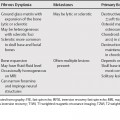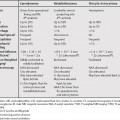65 Aortic wall motion can produce curvilinear artifacts in the proximal ascending aorta near the aortic root, which mimic a dissection. These artifacts are typically at the left anterior (12 to 1 o’clock) and right posterior (6 to 7 o’clock) locations.1 The true and false lumens are usually easily distinguished. However, the distinction can occasionally be difficult. The false lumen typically has a larger cross-sectional area. The presence of an acute angle between the flap and the outer wall (the “beak” sign) is seen only in the false lumen. Slender lines of low attenuation can be seen in the false lumen (the “cobweb” sign), which represent residual strands of the media. If one lumen wraps around another in the aortic arch, the inner lumen is the true lumen. Outer wall calcification always indicates the true lumen in an acute dissection. However, the outer wall of the false lumen can calcify in a chronic dissection if the false lumen lining endothelializes.2,3
Aortic Dissection
Stanford Classification
DeBakey Classification
Aortic Dissection versus Motion Artifact
True versus False Lumen
Features of the False Lumen in an Aortic Dissection
A Thrombosed False Lumen versus a Mural Thrombus
Stay updated, free articles. Join our Telegram channel

Full access? Get Clinical Tree





